An early 20th century painting of an Aberdeen fishing boat by a city-based fish porter will feature on a new set of stamps designed to “celebrate” Britain’s maritime heritage.
Amateur artist Alexander Harwood’s 1907 piece Briar, showing a herring drifter in Aberdeen harbour, is one of six designs which will be sold as Post and Go stamps in post offices across the country.
The six-piece set, entitled Working Sail, aims to acknowledge the little-known “pierhead painters” of the early 19th and 20th centuries.
Along with Mr Harwood’s painting, work by John William Green, George Race, Reuben Chappell, G Ramsay and Henry Lawson make up the first class collection.

Philip Parker, Royal Mail Stamps spokesman, said the stamps would be a reminder of a “proud heritage”
He said: “The UK has a rich maritime heritage, especially the working sailboats which served their communities throughout the 19th and into the 20th centuries.
“Whether for fishing or for carrying cargo or guiding larger vessels into port, these vessels were the workhorses of the sea, captured forever by the pierhead painters of the era. These new stamps are a reminder of this proud heritage.”
Mr Harwood moved to Aberdeen in 1901 and worked as a fish porter in the city’s busy harbour for most of his life while painting watercolours of the ships waiting in the port in his spare time.
He was a prolific amateur artist and painted hundreds of portraits of Aberdeen trawlers, working in watercolours, oils and gouache.
The pierhead painters had no formal training and would seek commissions to paint the daily life of a ship in port from the owners and crews.
They would sketch from life and produce portraits of the vessel before the ship sailed again, often simply as a supplement to the wages paid by their day jobs.
But for a few artists it became their means of livelihood.
The art they produced are mostly simple portraits of merchant ships and fishing vessels.
They have little in common with the elaborate seascape of the traditional and academic schools of marine art of the time.
Today much of the work of the pierhead painters is preserved in local and community museums around the country’s coast.